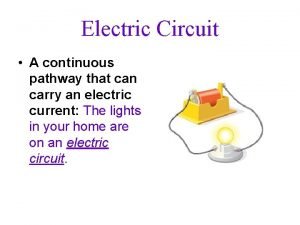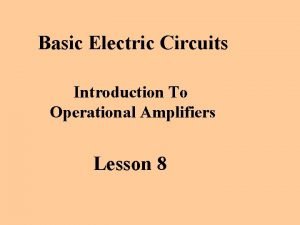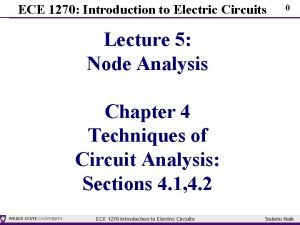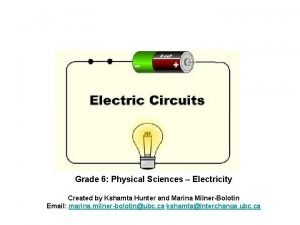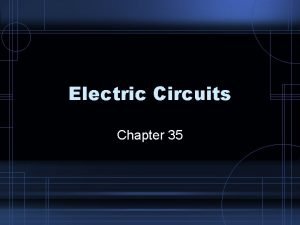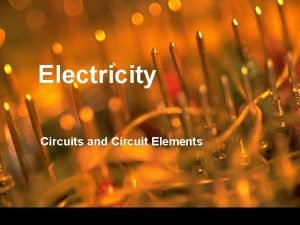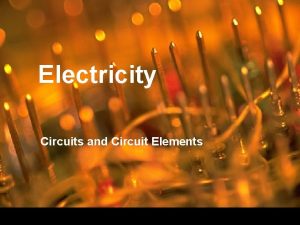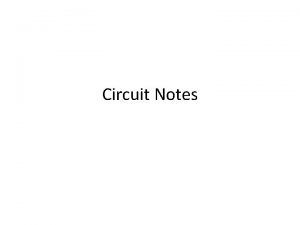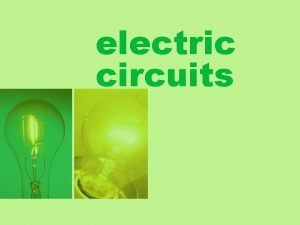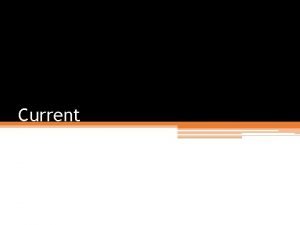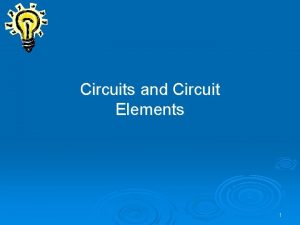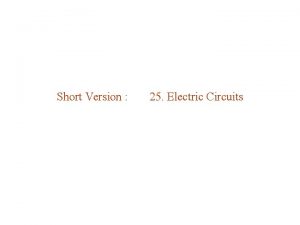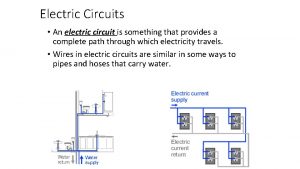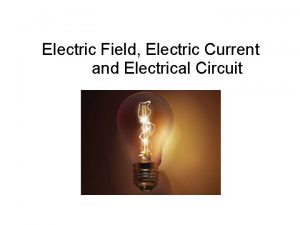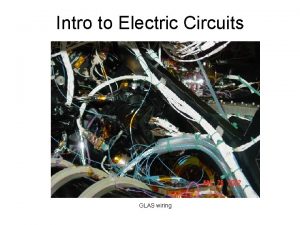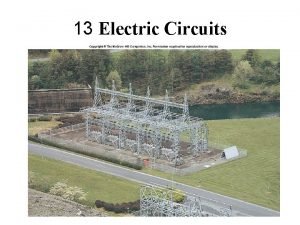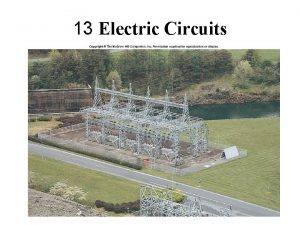Electric Circuits A circuit is a pathway that



















- Slides: 19

Electric Circuits • A circuit is a pathway that allows the flow of electricity. • Most electrical circuits use wires (as conductors), although others may use gases, other fluids or materials. • A circuit consists of an energy source, a load, a connector, and an electric circuit control device.

Parts of an Electric Circuit

Part of Circuit Energy Source Connectors Load Electric Circuit Function Examples Provide energy to the electrical load in the circuit. Batteries, generators, nuclear power plants, etc. Provide a controlled path for electric current to flow to each part of the circuit. Convert electrical energy into whatever form we need. Connecting wires, copper strips on printed circuit boards. To control the flow of electric current in the Switches, automatic timers, thermostats, Toaster, lamp, stereo, stove, microwave, etc.

Electric Circuits • Electric current flows in a continuous loop from the negative terminal of the cell, through the wires, the switch, and the electric load (light), and returns to the cell at the positive terminal. • From NEGATIVE Positive

Closed Circuit A circuit in which everything is connected and current is flowing.

Open Circuit A circuit in which there is a gap and the current is not making a complete circuit. + - ● ●

Circuit Diagrams and Symbols • Circuit drawings use special sets of symbols to represent electrical components and wiring. • Check out the standard electrical symbol and use a pencil to try and match the pictures to the symbols by drawing a line.

Circuit Diagrams and Symbols

Series Circuit A series circuit is when the elements in a circuit are connected so that there is only a single pathway for the current to flow.

Characteristics of a Series Circuit 1. As each load is added to a series circuit, the total resistance of the circuit increases. If the voltage remains the same and the resistance increases, the current flowing in the circuit decreases. 2. The electric current is the same in all parts of the circuit. 3. If the path of the current in a series circuit is broken at any point, the current stops flowing (If one bulb goes out, all bulbs go out). 4. Each time a dry cell is connected in series, the voltage is increased by 1. 5 V (Voltage is the sum of the cells in series). • 2 - 1. 5 volts cells in series = 3. 0 volts in the circuit.

Characteristics of a Series Circuit

Series Circuit Drawing Schematic Make sure to show positive and negative ends.

Parallel Circuit A parallel circuit is when the elements in a circuit are connected in such a way that there is more than one pathway for the current to flow.

Characteristics of a Parallel Circuit 1. Each separate circuit is called a branched circuit because each one is connected to its own branch circuit, it does not affect the other ones (if one lamp goes out, the others stay lit. ) 2. Note that each time another bulb is added in parallel to the circuit, the current from the battery increases. In any parallel circuit, the total current flowing from the source of the electrical energy equals the sum of all the separate branch currents in the circuit. 3. An interesting effect of connecting loads in parallel is that the total current always increases when you add another load.

Characteristics of a Parallel Circuit

Parallel Circuits Drawing Schematic

Parallel Circuit or Series Circuit?


Next class you will be put in groups of 2 or 3 and each group will be given a basket of circuit making materials. A list of questions will be presented to you and it will be up to you to manipulate and play with the materials in order to answer the questions. The questions that you answer and observations that you record will not be taken in and will be used as study notes for your unit test. A Circuit lab is also going to happen shortly which will be for marks and the notes you take during next class will help you complete the lab successfully.
 A suitable electric pump in an electric circuit is a
A suitable electric pump in an electric circuit is a Current in a parallel circuit
Current in a parallel circuit Walmart thất bại ở nhật
Walmart thất bại ở nhật Gây tê cơ vuông thắt lưng
Gây tê cơ vuông thắt lưng Block xoang nhĩ ecg
Block xoang nhĩ ecg Tìm vết của mặt phẳng
Tìm vết của mặt phẳng Sau thất bại ở hồ điển triệt
Sau thất bại ở hồ điển triệt Thể thơ truyền thống
Thể thơ truyền thống Hãy nói thật ít để làm được nhiều
Hãy nói thật ít để làm được nhiều Thơ thất ngôn tứ tuyệt đường luật
Thơ thất ngôn tứ tuyệt đường luật Tôn thất thuyết là ai
Tôn thất thuyết là ai Phân độ lown
Phân độ lown Present continuous carry
Present continuous carry Electrical circuit elements
Electrical circuit elements Electric circuits equations
Electric circuits equations Introduction to electric circuits
Introduction to electric circuits Kshamta hunter
Kshamta hunter Chapter 35 electric circuits
Chapter 35 electric circuits Electric circuits by james nilsson and susan riedel
Electric circuits by james nilsson and susan riedel Chapter 20 electric circuits
Chapter 20 electric circuits












